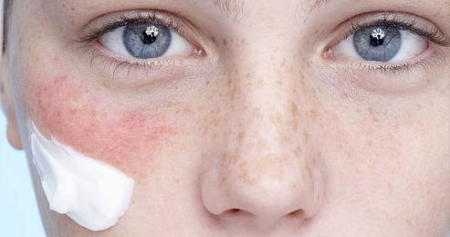Skin Rash
 Rash is a skin reaction that is usually temporary.
Rash is a skin reaction that is usually temporary.
Causes of Rashes
Rashes are generally broken into two categories: heat rashes and all other rashes. Heat rash (also known as prickly heat) is most generally found in babies and young children but can also afflict adults. Known as miliaria rubra, prickly heat is caused by an overreaction by the body to heat when it is unable to cool down sufficiently and the sweat ducts become blocked. This leads to the skin feeling very hot and a red rash is formed.
Some of the skin disorders that cause rashes are dermatitis, eczema, and psoriasis. Some health disorders can also cause a rash, including liver and gallbladder problems, bleeding disorders, lupus, deficiencies of vitamins B and C or omega-3 fatty acids, and autoimmune diseases.
Symptoms
Firstly, if rashes continue, if they tend to form a shape like a butterfly over the face, or if they are associated with joint pains and a high fever, see a physician immediately.
The general symptoms of both types of rashes can involve:
- A rash of pink or red bumps
- The parts of the body that sweat the most (or are exposed to sunlight) such as the neck and shoulders and the face
- An itching or prickling sensation
- Spots that fill with fluid and then turn into small blisters
- Irritability and restlessness
It is very possible that a person can suddenly develop a skin reaction to foods or products that were not reactive in the past. These can include perfumes, soaps, jewelry, fabric softeners, aftershaves, or even new clothing.
Diet for Rashes
The person with rashes should be assessed for obvious food allergies. If known are found, drink plenty of pure, filtered water. Avoid suspicious foods which may be the underlying cause. Common food allergies include citrus fruits, berries, peanuts, shellfish and dairy products.
A healthy diet for a person suffering from a rash would be to partake of green, leafy vegetables and yellow vegetables, such as carrots, pumpkin, sweet potatoes, and winter squash. Try to eat a wide variety of healthy foods and rotate these foods as much as possible.
Keep the body cool by consuming eight to 10 glasses of water per day.
Avoid the use of products containing aspartame.
Nutritional Therapy
Some of the nutritional products that can be helpful for rashes include:
- Vitamin A (both topically and orally)
- Vitamin C
- Vitamin E (also topically and orally)
- Take a teaspoon of baking soda or two Alka-Seltzer Gold tablets in water a few times a day until the rash subsides
- Flaxseed oil or eicosapentaenoic acid (EPA)
- Gamma-linolenic acid
Alternative Treatments
Many alternative treatments can also be used to treat common rashes. These treatments include:
- Ayurveda - Apply the pulp of a cilantro lead directly to the rash. Drink coriander tea or drink fresh cilantro (two tablespoons, three times a day)
- Herbs - Fresh aloe vera juice or gel can be helpful. Other herbs to try include burdock root, gentian root, and fresh juice of coriander (good for allergies, hay fever and several types of skin rashes)
- Homeopathy - Try belladonna, sulfur, graphites or calc. carb
- Juice Therapy - Many people find relief from the healthful effects of drinking fresh vegetable and fruit juices, particularly the juices from carrots, beets, radishes and garlic. Wheat grass juice is also known to be beneficial.
Hydrotherapy
According to some medical professionals, cold compresses can be applied as needed to control itching or pain. Also, soaking for 20 to 30 minutes in a warm alkaline bath containing bicarbonate of soda (approximately one cup) can be useful for alleviating the symptoms of urticaria, eczema, shingles, heat rash, poison ivy, sunburn and insect bites.
A few tablespoons of uncooked oatmeal can also be added to the water, then tie a pound of coarse, uncooked oatmeal into a cloth and add to the bath water. When the bath is full, the cloth filled with oatmeal can be used as a sponge to gently pat the areas which are suffering the most from irritation. While the skin continues to be irritated, a 30-minute oatmeal bath followed by patting the skin dry is a good course of action.
Naturopathic Medicine
Many naturopathic practitioners believe skin rashes are representative of an elimination of waste through the skin, or are an active immune response to an invading organism. When such a rash is suppressed these medical people argue the result can be a chronic disease, so they advise the most that should be done for the majority of rashes is to observe them and moderately treat the irritations that are a direct result. They advise avoiding any treatment in the early stages that makes the rash go away.
Topical Treatments
Hydrocortisone creams can be helpful. Calamine lotion should be avoided, however, as it clogs the pores.
References
- Balch, J.F. & Stengler, M. (2004). Prescription for Natural Cures: a self-care guide for treating diseases and health problems with natural remedies including diet and nutrition, herbal medicine, nutritional supplements, bodywork, and more. New Jersey: John Wiley and Sons Ltd
- De Vries, J. (1992). Skin diseases. Edinburgh : Mainstream
- Goodman, T. (1984).The skin doctor's skin doctoring book.New York : Sterling
- Papadopoulos, L. (2003). Understanding skin problems : acne, eczema, psoriasis and related conditions. Chichester, West Sussex : John Wiley and Sons Ltd
- Turkington, C., (1998). Skin deep : an A-Z of skin disorders, treatments and health. New York : Facts On File
Posted in Rash
Ask a Question Or Join a Discussion


